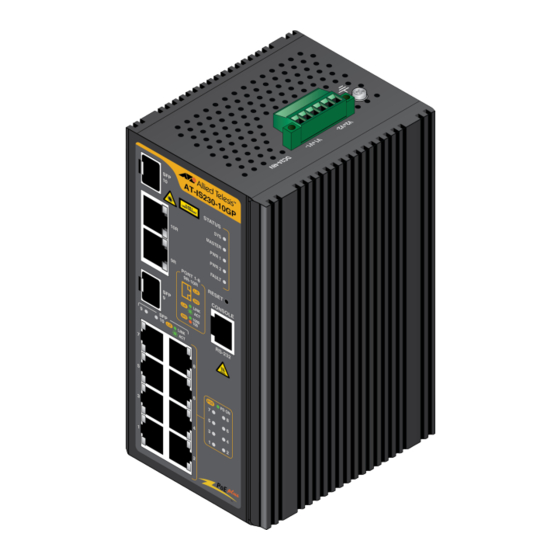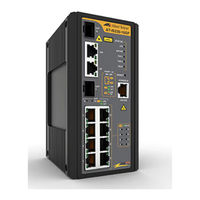
Allied Telesis IS230-10GP Managed Switch Manuals
Manuals and User Guides for Allied Telesis IS230-10GP Managed Switch. We have 4 Allied Telesis IS230-10GP Managed Switch manuals available for free PDF download: Web User Manual, Installation Manual, Reference Manual
Allied Telesis IS230-10GP Web User Manual (136 pages)
Industrial Ethernet Layer 2 Switch
Brand: Allied Telesis
|
Category: Network Router
|
Size: 6 MB
Table of Contents
-
Preface
16 -
-
-
Monitoring31
-
System38
-
IP Settings38
-
System Time42
-
Network Port43
-
-
L2 Switching45
-
Port Mirror46
-
-
Load Balance47
-
Q Vlan50
-
Port to VLAN52
-
Q-In-Q54
-
Garp55
-
Az EEE57
-
Multicast58
-
IGMP Querier59
-
MLD Settings61
-
MLD Snooping61
-
Router Ports61
-
MLD Querier62
-
Router Ports63
-
Jumbo Frame64
-
-
X-Ring Elite70
-
X-Ring Pro71
-
-
Security79
-
Applications84
-
IP Security89
-
Qos91
-
General91
-
Qos Settings92
-
Cos Mapping94
-
DSCP Mapping95
-
Rate Limit98
-
Egress Queue99
-
-
Management101
-
Lldp101
-
LLDP Overloading105
-
Snmp105
-
SNMP Settings105
-
SNMP Community106
-
Snmpv3 Settings107
-
SNMP Trap108
-
DHCP Server111
-
Status Settings111
-
Global Settings112
-
Port Settings113
-
VLAN Settings114
-
Global Settings116
-
Lease Entry116
-
SMTP Client116
-
Profile Settings117
-
Sending Message118
-
Rmon119
-
RMON Statistics119
-
RMON History120
-
RMON Alarm121
-
RMON Event122
-
Diagnostics123
-
Ping Test123
-
Ipv6 Ping Test125
-
Local Logging126
-
Logging Service126
-
System Log126
-
DDM129
-
LED Indication130
-
Tools131
-
Backup Manager131
-
Upgrade Manager133
-
Dual Image134
-
User Account134
-
Reboot Device135
-
Reset System135
-
-
-
-
Troubleshooting
136
Advertisement
Allied Telesis IS230-10GP Installation Manual (108 pages)
Industrial Ethernet Layer 2 Switches
Brand: Allied Telesis
|
Category: Switch
|
Size: 4 MB
Table of Contents
-
Preface
13 -
-
-
Features22
-
SFP Slots24
-
Console Port24
-
Leds25
-
-
Speed27
-
Duplex Mode27
-
MDI/MDIX29
-
Port Pinouts29
-
SFP Slots34
-
Ground Screw37
-
Leds40
-
Status Leds40
-
-
-
-
-
-
-
Certifications101
Allied Telesis IS230-10GP Installation Manual (94 pages)
Industrial Ethernet Layer 2 Switch
Brand: Allied Telesis
|
Category: Network Router
|
Size: 4 MB
Table of Contents
-
Preface
13 -
-
Features20
-
-
Poe Versions25
-
Poe Budget27
-
-
SFP Slots29
-
Console Port30
-
Reset Button31
-
Leds35
-
Status Leds35
-
-
-
-
-
Advertisement
Allied Telesis IS230-10GP Reference Manual (79 pages)
Industrial Ethernet Layer 2 Switch
Brand: Allied Telesis
|
Category: Switch
|
Size: 1 MB
Table of Contents
-
Preface
7 -
-
Flow Control18
-
Port Mirror18
-
802.1Q Vlan22
-
Q-In-Q27
-
Garp28
-
Gvrp28
-
Multicast30
-
MLD Snooping35
-
Jumbo Frame39
-
X-Ring Elite44
-
-
Qos53
-
Rate Limit55
-
-



